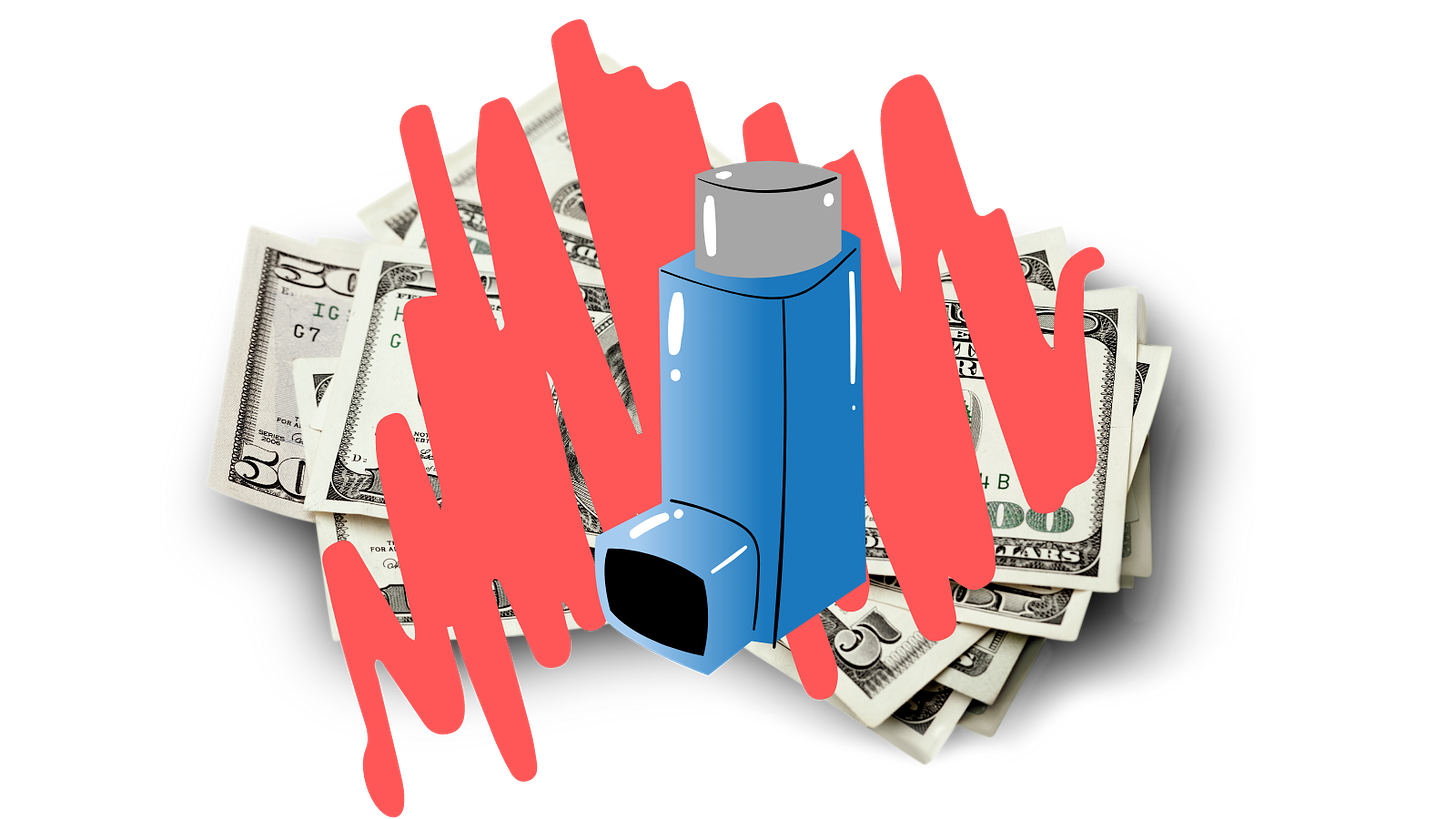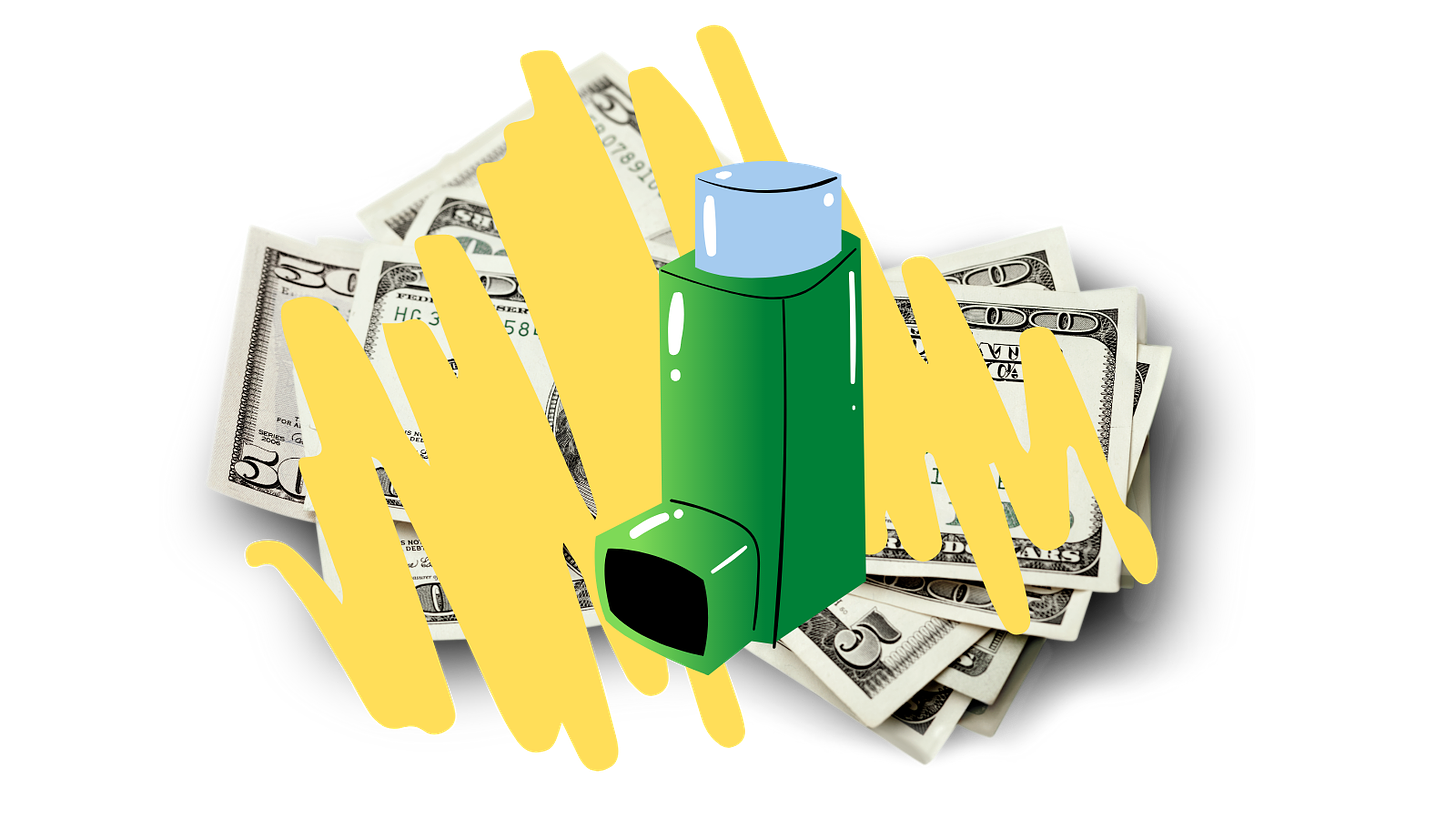

Discover more from HEALTH CARE un-covered
I just caused a long line at the pharmacy counter. And still paid $141 for an inhaler.
Have you heard the one about the former insurance executive who walked up to the pharmacy counter?
I’m not in the habit of wishing bad things to happen to anybody, but yesterday, when I was at the pharmacy counter, I was wishing every member of Congress would have to experience the same insanity I was experiencing. If they did, they just might do something to fix the growing crisis they helped create when they passed the so-called “Medicare Modernization Act” (MMA) in 2003.
Some background: A few days ago, I had a follow-up visit with my pulmonologist. My primary care doctor had referred me to her some time ago when I developed a cough and laryngitis that would not go away. She prescribed a Symbicort inhaler, which despite the fact that I pay good money every month for a Medicare Part D drug plan, requires me to pay $606 out of my own pocket for a three-month supply.
During my follow-up visit, I asked her if there was a generic inhaler that would be cheaper. It turns out that there is: fluticasone propionate-salmeteroL. It isn’t a generic version of Symbicort but of a similar inhaler called Wixela Inhub. She wrote me a script for the generic version of the inhaler and I took it to my local Rite Aid last night.
We’ve been led to believe that generics cost us less than brand-name drugs. While it is true that the list price of generics is typically cheaper, often much cheaper, than brand-name drugs, in the illogical world of U.S. health care, you can wind up paying more out of pocket for a generic than a brand-name drug, as I found out.
You also need to know that Medicare drug plans often don’t provide any coverage for cheaper generics, thanks to secretive rebate deals, allowed if not enabled by the MMA, that insurance companies and their PBMs cut with drug makers. Major parts of the MMA were written by lobbyists for insurance and drug companies to ensure big profits, and those lobbyists worked overtime when the bill was being voted on to get the bill passed as they wrote it. I know this because I was at Cigna when Congress passed that bill in the middle of the night after many hours of arm-twisting by said lobbyists. One of my jobs back then was to provide Cigna’s government affairs team with talking points to use with lawmakers.
Well, my drug plan (marketed by WellCare, whose tagline is, “Beyond Healthcare. A Better You”) provides no coverage whatsoever for the generic inhaler my pulmonologist prescribed.
After hearing from many other folks that Part D drug plans often provide skimpy coverage for drugs they needed, I enrolled in GoodRx, which provides significant discounts for many medications. DrugRx compares drug prices and tracks down coupons that can yield significant savings. What I have come to realize is that my out-of-pocket obligation is often considerably less if I use GoodRx instead of my WellCare plan. When I was told I would have to pay the full retail price of the generic inhaler under my WellCare plan, I asked the pharmacist what the GoodRx cost would be. She told me a one-month supply of the generic would cost $102.17. I could save $20.01 per unit if I paid $286.50 for a three-month supply.
Just as I was about to go with the GoodRx deal, it occurred to the pharmacist to see if my plan would cover the brand-name version of the same medication. Lo and behold, WellCare does indeed cover Wixela, just not the generic. That’s undoubtedly because of the deal WellCare struck with Mylan Pharmaceutical, which makes Wixela. If I went with Wixela, I would have to pay $47 out-of-pocket for a one-month supply (but no discount for a three-month supply), which is $55.17 per unit cheaper than the GoodRx generic price.
This all took some time, as you can imagine. Meanwhile, the line behind me grew longer and longer. I cannot imagine what it is like to be a pharmacist these days.
I’m fortunate that I can afford to pay $141 for a three-month supply of Wixela, and even, albeit reluctantly, $606 for three months worth of Symbicort. Many Americans are not so fortunate. In fact, millions of us with insurance–both public, like Medicare, and private, including employer-sponsored coverage–walk away from the pharmacy counter without our often life-saving drugs because of what our insurance plans make us pay out of pocket.
Many people of course don’t have a clue that they might be able to get their medications at a lower price without using their insurance card, either through outfits like GoodRx or by using manufacturers’ coupons.
And many of us, especially those of us dealing with cancer, MS, or other life-threatening chronic conditions, often have to spend thousands of dollars out of our own pockets before our coverage kicks in for even the drugs our insurance plans will cover. This is why so many of us with insurance get buried under mountains of debt and feel we have no alternative other than to beg for money on GoFundMe or file for bankruptcy.
Back to that so-called Medicare Modernization Act of 2003. Not only did it make the Part D drug benefit nearly impossible to figure out because of the ever-changing list of medications insurance plans will or will not cover, but it also prohibited Medicare from negotiating with drug companies for lower prices as the Veterans Administration program can do.
In Nation on the Take, the book I co-authored with Nick Penniman of Issue One, I cited the MMA as an example of how well-funded special interests are almost always able to call the shots in Washington. Here’s a paragraph from the book that provides a hint of how that industry-backed bill got across the finish line:
When asked why he thought House leaders had scheduled the vote long after most Americans had gone to bed, Representative Dan Burton (R-IN), who voted against the bill, said: “A lot of shenanigans were going on that night (that) they didn’t want on national television.” Among the shenanigans, reportedly sanctioned by House leaders: freezing C-SPAN cameras and allowing lobbyists on the House floor as the vote was being taken.
Those shenanigans have led to the financial ruin and premature death of countless Americans. But year after year, Congress has looked the other way. To change that, more than 50 organizations and businesses have come together in a coalition to demand that lawmakers take action to address what has become not only a national disgrace but a growing crisis.
The good news is that just after a few months, the Lower Out of Pockets NOW coalition is being noticed by members of Congress on both sides of the political aisle. We are determined to hold our lawmakers accountable. Some members are even talking about forming a caucus within Congress to explore solutions.
You can be sure I will keep you posted.
Subscribe to HEALTH CARE un-covered
Pulling back the curtains on how Big Health is hurting Americans and how we got to this point.








Out of pocket thru Canada….THREE Serevent Diskus (salmeterol xinafoate) from Canada via Mauritius scheduled to arrive including shipping: $67.99. Generic Ventolin: THREE inhalers @ $56.74 inclusive shipping right from Vancouver, BC. Thank you 🇨🇦! I’m an old hand at this now. If you’re picking up inhalers in the US you’re overpaying.
A few questions:
1) Was the initial Symbicort filled at a CVS rather than a Rite Aid?
2) Was your 3 month supply of symbicort going to be $606 at refill, or did you not check?
I ask because $606 is $480 + $126 - you met your $480 deductible on that fill and then you paid the Wellcare "preferred pharmacy" copay of $126 for 3 months for a tier 3 branded medication (in a single transaction of $606, but still). CVS is a preferred pharmacy in Wellcare's network, Rite Aid is a standard pharmacy, resulting in an out of pocket cost difference of $5/month ($15/3 months).
I suspect that your symbicort would be $126 at refill time, not $606.
Also, had you not filled the symbicort earlier in the plan year, your Wixela would have been $621, not $141, because you wouldn't have met the $480 deductible yet.
Is this insanely complicated and stupid? Yes.
Today at the pharmacy, I was discussing options with a patient who had Wellcare Part D coverage. Based on the low acquisition costs of the 4 medications he was taking, I suspected that all 4 drugs would be tier 1 (at most 2) on his plan's formulary. To my surprise, one was tier 1, two were tier 2 and the fourth was tier 3. This meant that his copays, rather than being the expected $10/month for each, were in fact $10/month, $20/month, $20/month and $47/month (after meeting a $480 deductible). So the total copayments per month added up to $97/month, not $40-50 that I expected to see.